Genre: Platformer Developer: Shiny Ent. Publisher: Playmates Players: 1 Released: 1994
in 1994, perhaps the year for 2-D action titles. Only Donkey Kong Country received more attention. The game’s success was such that it spawned a variety of spinoffs (cartoons, action figures…), plus numerous sequels and updates.
I rented the Super NES version of the game soon after it was released and received it as a Christmas gift in 1994. I sold it in 1995-1996, along with all my systems and games. A few months ago, I bought a used Genesis, and soon after that I was fortunate enough to find a copy of Earthworm Jim for a few dollars. I immediately brought it home, and memories resurfaced as I put the cart in the Genesis for a first time. It easily lived up to my renewed expectations and is an obligatory purchase for every self-respecting retro gamer.
As momentous as it seemed at the time, game players could see Earthworm Jim coming. The leader of newly-founded Shiny Entertainment, David Perry, had been in charge of three key 1992-1993 Genesis games that were published by Virgin: Global Gladiators, Cool Spot and Aladdin. These titles featured ultra-smooth animation, cartoon-like graphics, and a peculiar sense of humor. But as good as they undoubtedly were, they still had some limitations: they offered a limited number of techniques, and their levels were a tad repetitive despite frequent changes in the scenery. Earthworm Jim has none of these drawbacks. The stages’ environments could not be more dissimilar: a junkyard, ‘hell,’ abstracted wastelands, underwater tunnels, intestines (!), and more.
Jim’s basic means of attack are more elaborate than Cool Spot‘s or Aladdin‘s: he has a plasma gun with possible enhancements; he can use a ‘whip,’ which is in fact his earthworm self. Moreover, each level brings forward new techniques. There are eight levels overall, and most of them have two or three different sections. The first two stages are probably the most conventional in the whole game, but they still reconfigure standard platform rules in their own way, with odd bosses (a snowman in hell?), enemies (a businessman) and obstacles. Later in the game, the player has to pilot a submersible, do some bungee-jumping, protect a little dog, control Jim while he’s out of his suit, travel in intestines, etc. Between levels, a forward-scrolling race against Psy-Crow can net you a continue, but also a lost life if a) the race is lost, and b) the subsequent battle with Psy-Crow also results in defeat. These obligatory bonus levels are quite exciting and do not slow down the game too much.
The smooth animation might aim at a certain ‘realism,’ but when we look closer the game is a pure fantasy, a surrealist fantasy. The junkyard in the first level is not a ‘real’ junkyard, but a bizarre, almost poetic take on what that place represents. Much like the second level, it is filled with textured, dense platforms that remind me of some of Giotto’s paintings. Some sequences verge on pure abstraction, like when Jim, stripped of his suit, has to dodge flames in front of a pitch-black background. Most of the game’s figures are abstracted. The dogs in the first level are an outrageous assortment of wild hair and long teeth; the second boss, a cat, has an edgy look; frog-like creatures and hidden monsters can be found in Buttville.
The story itself is pure stream-of-consciousness stuff: an indestructible suit falls on Earth, ‘connects’ with an earthworm and propels the latter in a fantastic adventure. The music follows suit (no pun intended), with deliberately out-of-place tunes (a banjo song during a race in space) and occasional nods to classical pieces (Mussorgky’s Night on the Bald Mountain in the second level). Some of the themes are driven by solid beats (Down the Tubes), while others are ambient in tone (Intestinal Distress). The sound effects are just as bizarre. When you’re in hell, you hear all sorts of grunts, shouts and cries; many enemies actually have a voice; Jim himself has a fairly wide vocabulary, whether he is celebrating a victory, shouting in pain or mumbling after a crushing defeat. Meanwhile, the whipping sound (which one hears a lot throughout the game) is as clear as one could wish for.
You can choose among three difficulty settings, and even at normal the game is very challenging. The first few stages are straightforward enough, but starting with the aptly named Level 5, the trials get tougher. With the exception of the fourth level, the bungee-jumping Snot a Problem, the stages are long, and it takes close to two hours to complete the game (the final boss is not quite as hard as one could have expected). More and more precise actions are required as the game goes on, most of them involving the whip. The whipping controls are responsive but very demanding: you sometimes have to swing from hook to hook in order to reach certain areas, and multiple tries are often necessary. One must also be cautious about Jim’s jumping. Trying to jump at the very end of a platform could lead to unwanted backtracking (especially in the Intestinal Distress level, a Genesis exclusive) and even a quick end.
The game’s controls enable comparison with Battletoads: failures are less due to a lack of precision in the controls than to the tremendous skill asked from the player. In other words, Earthworm Jim plays it fair: several segments are very difficult, but once you have mastered a move or a particular section, it should not cause you major problems afterwards. Still, prepare to lose some lives when you encounter the later levels for a first time…
Earthworm Jim‘s stages are interesting and varied enough to warrant innumerable tries. But much like its contemporary Ristar, the game’s replay value is also bolstered by secret codes that open up new modes of play: some change Jim’s appearance; others give him invincibility or unlimited ammunition; there is a level skip and a level select; etc.
As good as Global Gladiators, Cool Spot, and Aladdin were, David Perry and his crew reached even higher platform gaming heights with Earthworm Jim. No longer constrained by a license, they successfully blended the charm and beauty of these three games with the radical level design and techniques of Rare’s extraordinary Battletoads. Their creation lived its own life, undisturbed by the imposing shadows of its predecessors.


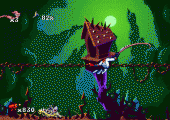
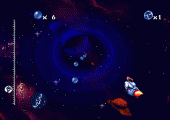
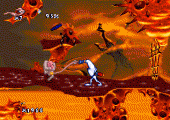
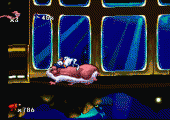
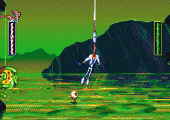
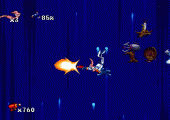
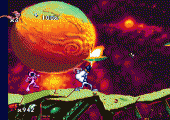
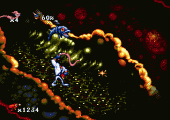
Wow, Earthworm Jim is a masterpiece. Eye candy graphics and animations, crisp controls, mad artistic direction and level design. Heterogenous (less than the second episode but…) and funny as sh*t, David Perry’s sluggy baby is an incredible plateformer. CONCLUSION: 9/10 (because Earthworm Jim 2 deserves the 10/10)
I’m a little surprised to see this given a 10, but I do understand it. Earthworm Jim did so many things right, and there’s hardly any faults. I preferred the second, but the original is absolutely a must-own.